cruise control BUICK CENTURY 1996 Owners Manual
[x] Cancel search | Manufacturer: BUICK, Model Year: 1996, Model line: CENTURY, Model: BUICK CENTURY 1996Pages: 340, PDF Size: 17.61 MB
Page 85 of 340
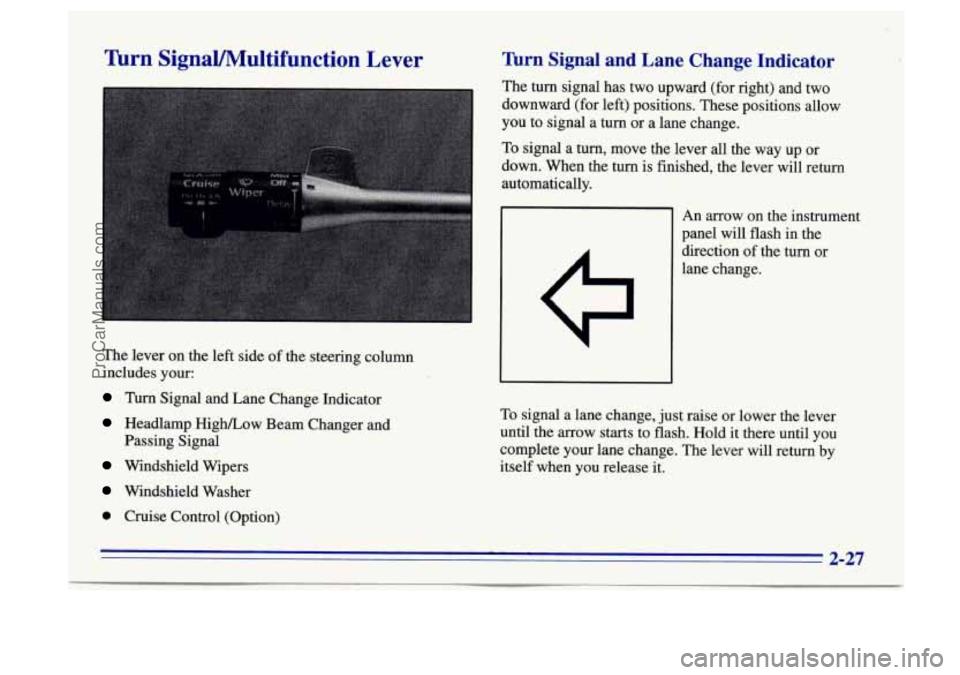
Wrn SignaVMultifunction Lever
The lever on the left side of the steering column
includes your:
Turn Signal and Lane Change Indicator
Headlamp High/Low Beam Changer and
Passing Signal
Windshield Wipers
Windshield Washer
0 Cruise Control (Option)
Turn Signal and Lane Change Indicator
The turn signal has two upward (for right) and two
downward (for left) positions. These positions allow
you to signal a turn or a lane change.
To signal a turn, move the lever all the way up or
down. When the turn is finished, the lever will return
automatically.
An arrow
on the instrument
panel will flash in the
direction
of the turn or
lane change.
To signal a lane change, just raise or lower the lever
until the arrow starts to flash. Hold it there until you
complete your lane change. The lever will return by
itself when you release it.
2-27
ProCarManuals.com
Page 88 of 340
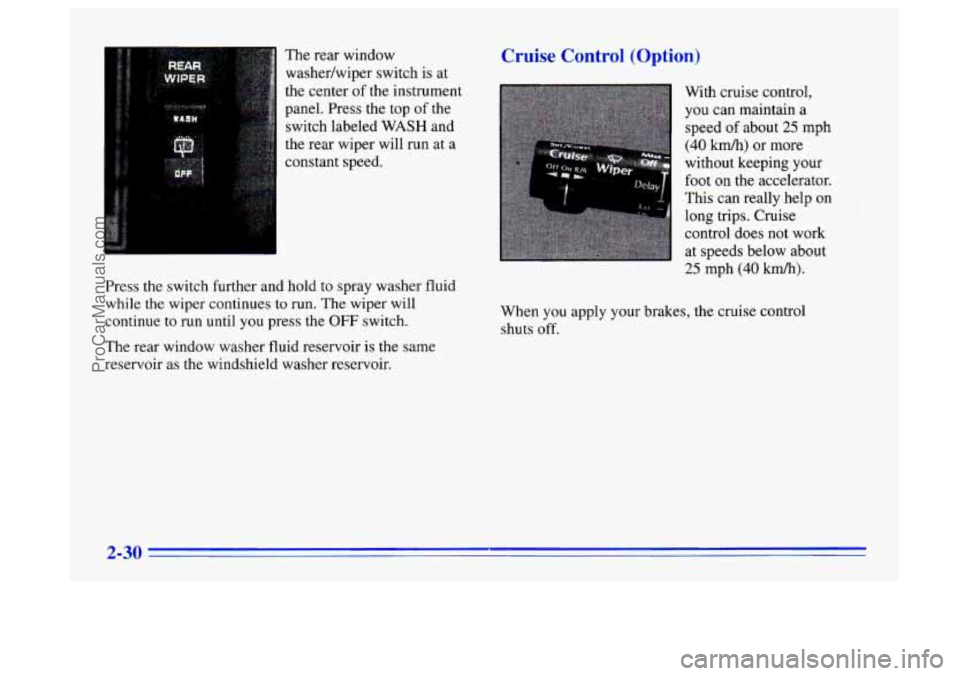
The rear window
washedwiper switch is at
the center of the instrument
panel. Press the top
of the
switch labeled
WASH and
the rear wiper will run at a
constant speed.
Press the switch further and hold
to spray washer fluid
while
the wiper continues to run. The wiper will
continue to run until you press the
OFF switch.
The rear window washer fluid reservoir is the same
reservoir as the windshield washer reservoir.
Cruise Control (Option)
With cruise control,
you can maintain
a
speed of about 25 mph
(40 km/h) or more
without keeping
your
foot on the accelerator.
This can really help on
long trips. Cruise
control does not work
at speeds below about
25 mph (40 km/h).
When you apply your brakes, the cruise control
shuts
off.
2-30
ProCarManuals.com
Page 89 of 340
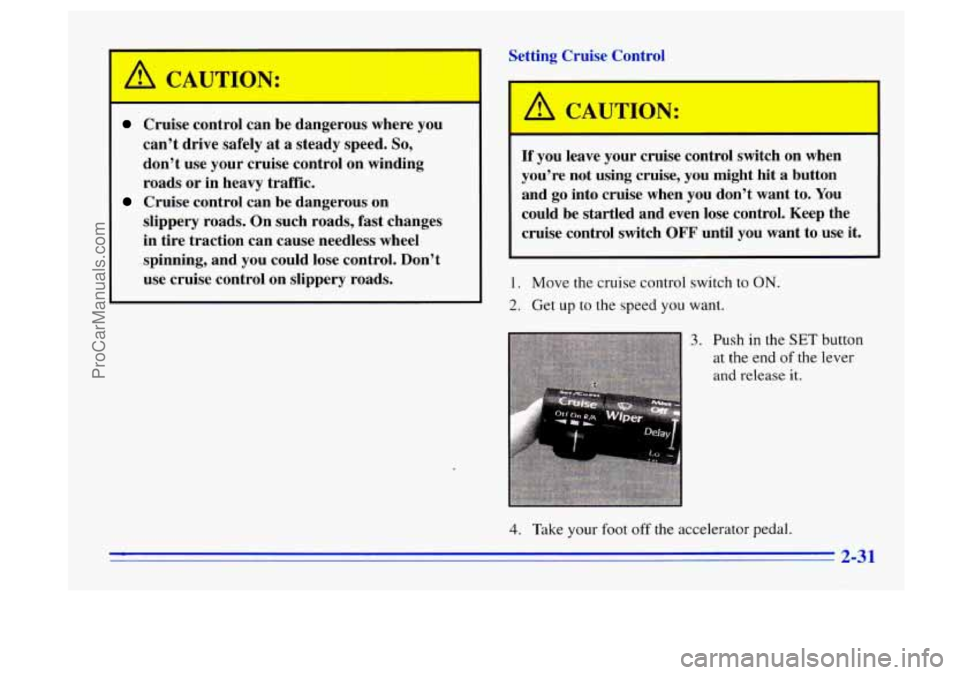
I
Cruise control can be dangerous where you
can't drive safely at
a steady speed. So,
don't use your cruise control on winding
roads or in heavy traffic.
slippery roads.
On such roads, fast changes
in tire traction can cause needless wheel
spinning, and you could
lose control. Don't
use cruise control on slippery roads.
Cruise control can be dangerous on
If you leave your cruise control switch on when
you're not using cruise, you might hit
a button
and go into cruise when you don't want to.
You
could be startled and even lose control. Keep the
cruise control switch
OFF until you want to use it.
1. Move the cruise control switch to ON.
2. Get up to the speed you want.
3. Push in the SET button
at
the end of the lever
and release it.
4. Take your foot off the accelerator pedal.
2-31
ProCarManuals.com
Page 90 of 340
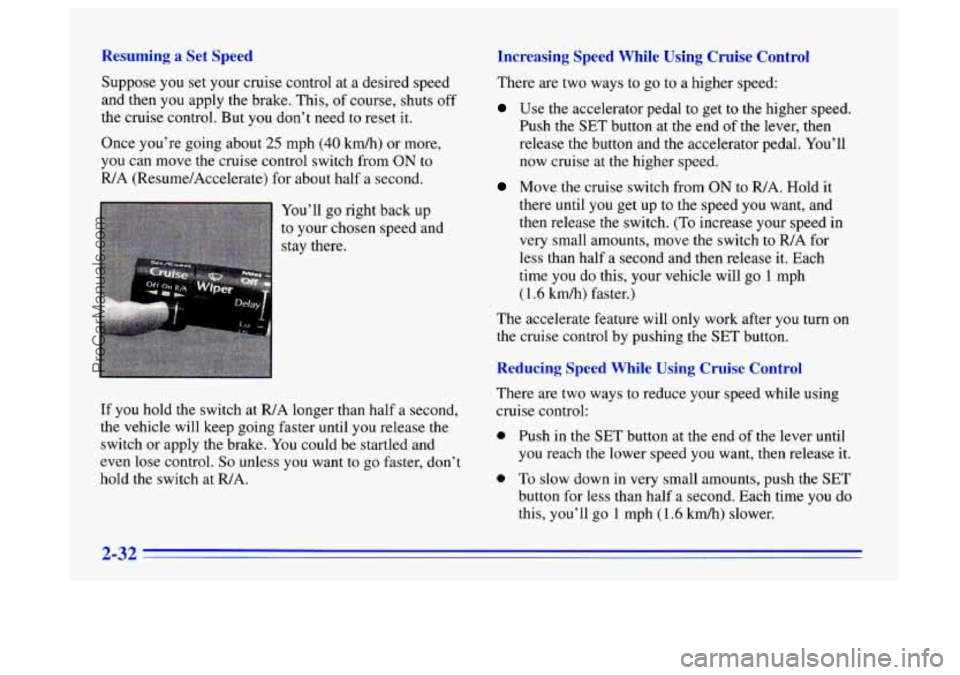
Resuming a Set Speed Increasing Speed While U
Suppose you set your cruise control at a desired speed
and then you apply the brake. This, of course, shuts off
the cruise control. But
you don’t need to reset it.
Once you’re going about
25 mph (40 km/h) or more,
you can move the cruise control switch from ON to
R/A (Resume/Accelerate) for about half
a second.
You’ll go right back up
to your chosen speed and
stay there.
If you hold the switch at R/A longer than half a second,
the vehicle will keep going faster until you release the
switch or apply the brake. You could be startled and
even lose control.
So unless you want to go faster, don’t
hold the switch at
WA.
There are two ways to go to a higher speed:
Use the accelerator pedal to get to the higher speea.
Push the
SET button at the end of the lever, then
release the button and the accelerator pedal.
You’ll
now cruise at the higher speed.
Move the cruise switch from ON to WA. Hold it
there until you get up to the speed
you want, and
then release the switch.
(To increase your speed in
very small amounts, move the switch
to R/A for
less than half a second and then release it. Each
time you do this, your vehicle will go
1 mph
(1.6 km/h) faster.)
The accelerate feature will only work after you turn on
the cruise control by pushing the SET button.
There are two ways to reduce your speed while using
cruise control:
0 Push in the SET button at the end of the lever until
you reach the lower speed you want, then release it.
0 To slow down in very small amounts, push the SET
button for less than half a second. Each time you do
this, you’ll go
1 mph (1.6 km/h) slower.
2-32
ProCarManuals.com
Page 91 of 340
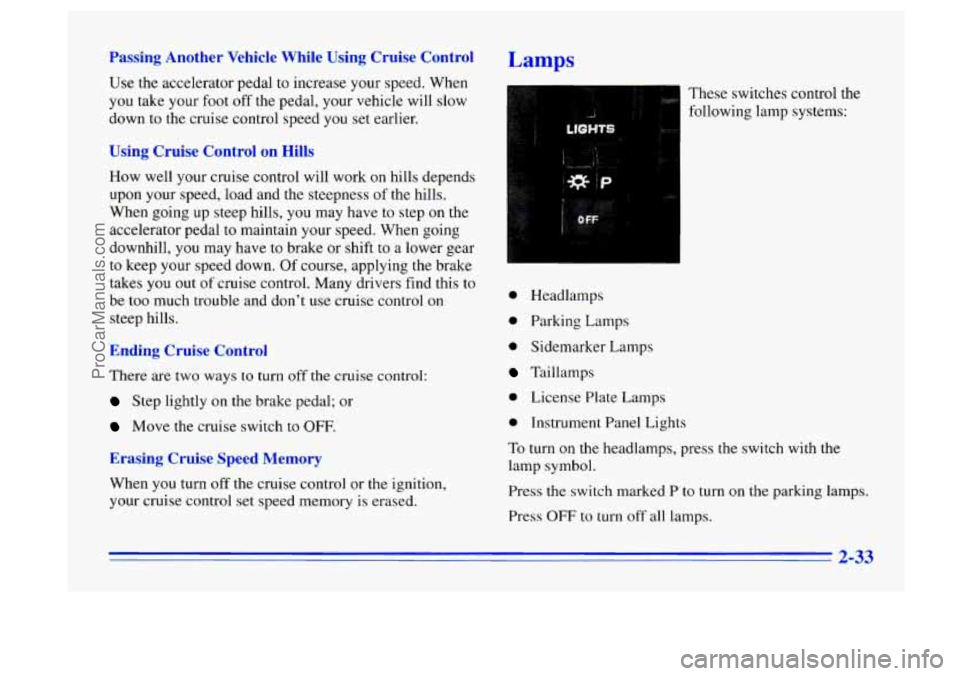
Passing Another Vehicle While Using Cruise Control
Use the accelerator pedal to increase your speed. When
you take your foot off the pedal, your vehicle will slow
down
to the cruise control speed you set earlier.
Using Cruise Control on Hills
How well your cruise control will work on hills depends
upon your speed, load and the steepness
of the hills.
When going up steep hills, you may have to step
on the
accelerator pedal to maintain your speed. When going
downhill, you may have to brake or shift
to a lower gear
to keep your speed down. Of course, applying the brake
takes you out
of cruise control. Many drivers find this to
be
too much trouble and don’t use cruise control on
steep hills.
Ending Cruise Control
There are two ways to turn off the cruise control:
Step lightly on the brake pedal; or
Move the cruise switch to OFF.
Erasing Cruise Speed Memory
When you turn off the cruise control or the ignition,
your cruise control set speed memory is erased.
Lamps
..
li
LtOWtS
0 Headlamps
0 Parking Lamps
0 Sidemarker Lamps
Taillamps
0 License Plate Lamps
0 Instrument Panel Lights
To turn on the headlamps, press the switch with the
lamp symbol.
Press
the switch marked P to turn on the parking lamps.
Press
OFF to turn off all lamps.
2-33
ProCarManuals.com
Page 264 of 340
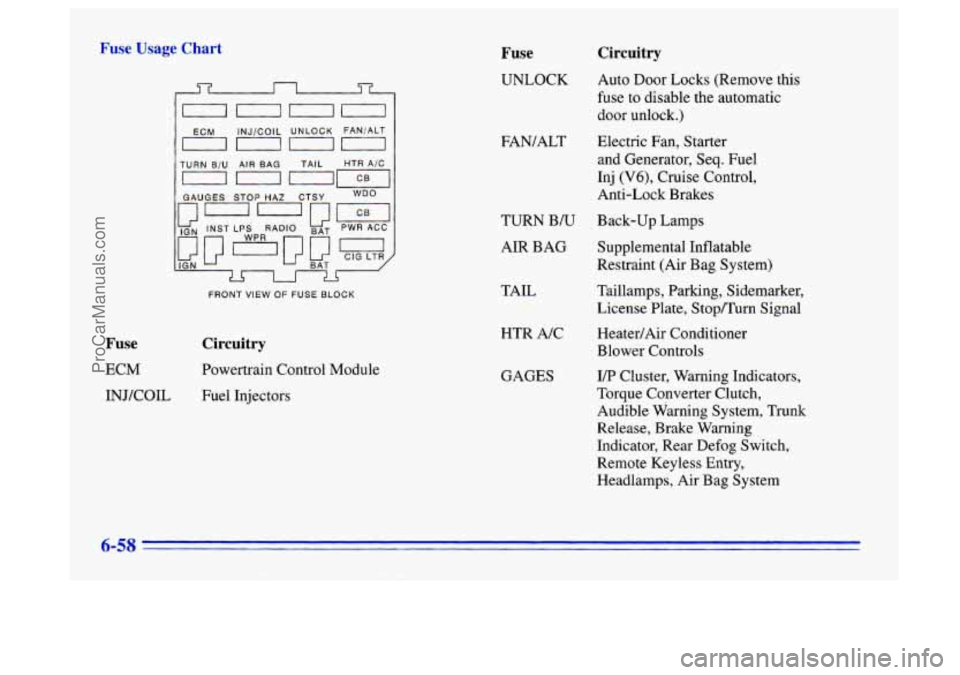
Fuse I qe Chart Fuse Circuitry
I----
ECM INJ/COIL UNLOCK FANiALT
GAUGES
STOP HAZ CTSY WDo
FRONT VIEW OF FUSE BLOCK
Fuse
ECM INJ/COIL
Circuitry
Powertrain Control Module Fuel Injectors UNLOCK Auto
Door Locks (Remove
this
fuse to disable the automatic
door unlock.)
FAN/ALT Electric Fan, Starter
and Generator, Seq. Fuel
Inj
(V6), Cruise Control,
Anti-Lock Brakes
TURN B/U Back-up Lamps
AIR BAG Supplemental Inflatable
Restraint (Air Bag System)
TAIL
HTR A/C
GAGES Taillamps,
Parking, Sidemarker,
License Plate, Stopflurn Signal
Heater/Air Conditioner
Blower Controls
IA? Cluster, Warning Indicators,
Torque Converter Clutch,
Audible Warning System, Trunk
Release, Brake Warning
Indicator, Rear Defog Switch,
Remote Keyless
Entry,
Headlamps, Air Bag System
6-58
ProCarManuals.com
Page 310 of 340
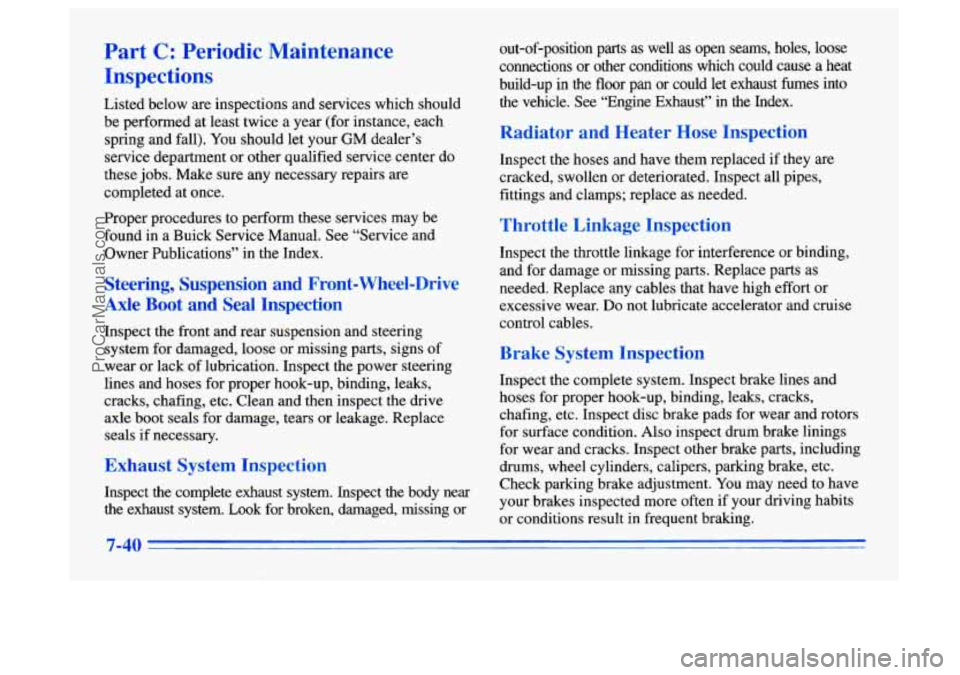
Part C: Periodic Maintenance
Inspections
Listed below are inspections and services which should
be performed
at least twice a year (for instance, each
spring and fall). You should
let your GM dealer’s
service department or other qualified service center do
these jobs. Make sure an.y necessary repairs are
completed at once.
Proper procedures to perform these services may be
found in a Buick Service Manual. See “Service and
Owner Publications” in the Index.
Steering, Suspension and Front- Wheel-Drive
Axle Boot and Seal Inspection
Inspect the front and rear suspension and steering
system for damaged, loose or missing parts, signs of
wear or lack of lubrication. Inspect the power steering
lines and hoses for proper hook-up, binding, leaks,
cracks, chafing, etc. Clean and then inspect the drive
axle boot seals for damage, tears or leakage. Replace
seals if necessary.
Exhaust System Inspection
Inspect the complete exhaust system. Inspect the body near
the exhaust system.
Look for broken, damaged, missing or out-of-position parts as well
as open seams, holes, loose
connections or other conditions which could cause a
heat
build-up in the floor pan or could let exhaust fumes into
the vehicle. See “Engine Exhaust” in the Index.
Radiator and Heater Hose Inspection
Inspect the hoses and have them replaced if they are
cracked, swollen or deteriorated. Inspect all pipes,
fittings and clamps; replace as needed.
Throttle Linkage Inspection
Inspect the throttle linkage for interference or binding,
and for damage or missing parts. Replace parts
as
needed. Replace any cables that have high effort or
excessive wear.
Do not lubricate accelerator and cruise
control cables.
Brake System Inspection
Inspect the complete system. Inspect brake lines and
hoses for proper hook-up, binding, leaks, cracks,
chafing, etc. Inspect disc brake pads for wear and rotors
for surface condition. Also inspect drum brake linings
for wear and cracks. Inspect other brake parts, including
drums, wheel cylinders, calipers, parking brake, etc.
Check parking brake adjustment. You may need to have
your brakes inspected more often if your driving habits
or conditions result in frequent braking.
7-40
ProCarManuals.com
Page 331 of 340
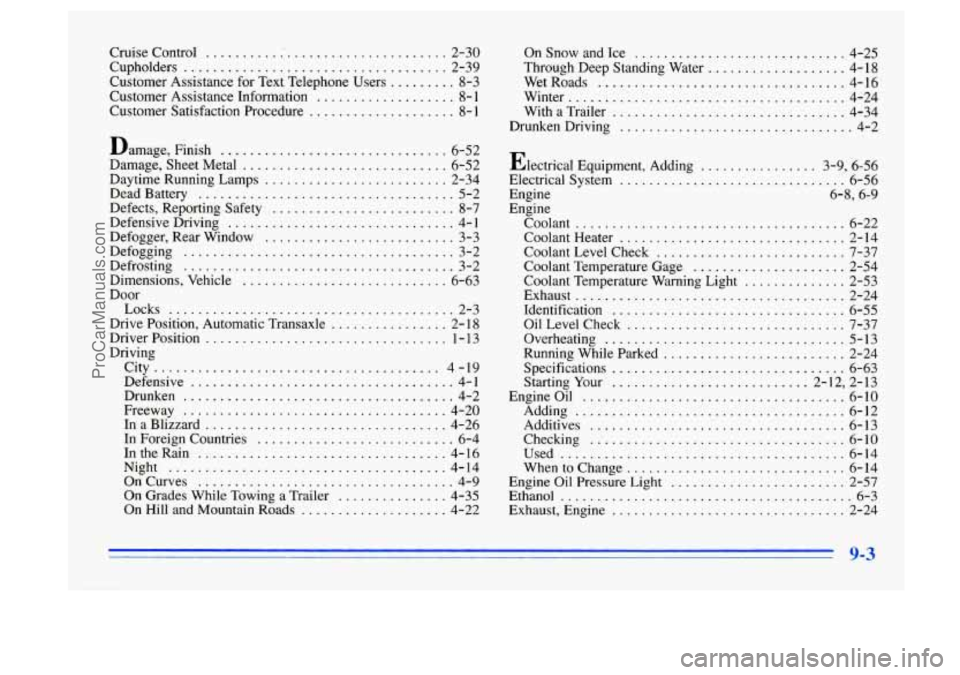
Cruise Control .................................. 2-30
Cupholders
.................................... 2-39
Customer Assistance Information
................... 8- 1
Customer Satisfaction Procedure .................... 8- 1
Damage. Finish ............................... 6-52
Damage. Sheet Metal
............................ 6-52
Daytime Running Lamps
......................... 2-34
Dead Battery
................................... 5-2
Defects. Reporting Safety
......................... 8-7
Defensive Driving
............................... 4- 1
Defogger. Rear Window
.......................... 3-3
Defogging
..................................... 3-2
Defrosting
..................................... 3-2
Dimensions. Vehicle
............................ 6-63
Door
Drive Position. Automatic Transaxle
................ 2- 18
Driver Position
................................. 1 - 13
Driving
City
....................................... 4-19
Defensive
.................................... 4-1
Drunken
..................................... 4-2
Freeway
.................................... 4-20
In a Blizzard ................................. 4-26
In Foreign Countries
........................... 6-4
IntheRain
.................................. 4-16
Night
...................................... 4-14
OnCurves
................................... 4-9
On Grades While Towing a Trailer ............... 4-35
On Hill and Mountain Roads
.................... 4-22
Customer Assistance for
Text Telephone Users
......... 8-3
Locks
....................................... 2-3 OnSnowandIce
............................. 4-25
Wet Roads
.................................. 4-16
Winter ...................................... 4-24
With a Trailer
................................ 4-34
DrunkenDriving
................................ 4-2
Electrical Equipment. Adding
................ 3-9. 6-56
Electrical System
............................... 6-56
Engine 6-8. 6-9
Engine
Coolant
..................................... 6-22
Coolant Heater
............................... 2-14
Coolant Level Check
.......................... 7-37
Coolant Temperature Gage
..................... 2-54
Exhaust
..................................... 2-24
Identification
................................ 6-55
OilLevelCheck
.............................. 7-37
Overheating
................................. 5-13
Running While Parked ......................... 2-24
Specifications
................................ 6-63
Starting Your
........................... 2- 12. 2-13
Engineoil
.................................... 6-10
Adding
..................................... 6-12
Additives
................................... 6-13
Checking
................................... 6-10
Used
....................................... 6-14
Whentochange
.............................. 6-14
Engine
Oil Pressure Light ........................ 2-57
Ethanol
........................................ 6-3
Through Deep Standing
Water
................... 4-18
Coolant Temperature Warning Light
.............. 2-53
Exhaust. Engine
................................ 2-24
9-3
ProCarManuals.com